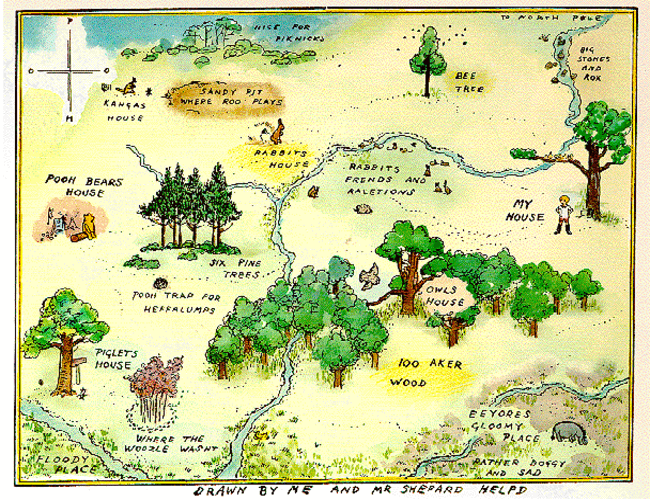(courtesy Wikipedia)
SNAPSHOT
In this video, we’ll look at the story of how Winnie-the-Pooh pays so much attention to place, and how the map of the Hundred-Acre Wood, drawn by E.H. Shepard, allows us all to visit childhood for a little while. (courtesy Laughing Squid (c) Great Maps Explained)
One of the lovely things about revisiting the treasured books of your childhood is that you get to live in some wonderful places of imagined bliss where characters are loved, the world is largely safe and only good and wonderful things happen.
Not everything is perfect all the time but it’s perfect enough that you can let yourself fall into the embrace of a world where untroubled happiness seems possible and nowhere does this seem more achievable than in A. A. Milne’s Winnie-the-Pooh stories (and in a sequel too, penned quite a few years later than the originals, by David Benedictus) which takes physical form in the Hundred-Acre Wood which as this beautifully put-together video makes clear, combines real landmarks and fictional places to create a bucolic idyll where we can live out our childhoods again.
While no one knows for sure, it’s likely that both A. A. Milne and E. H. Shepard created the Hundred-Acre Wood (really 500 acres and part of the larger well-protected Ashdown Forest) as an antidote to their horrific experiences in the war, and made it a place where all children could feel they might be at home too.
As the video points out, it’s a specific enough place for us to feel that we can imprint our own sense of place onto it, and the magic of the Hundred-Acre Wood is that it is a home not just for Christopher Robin, Pooh, Piglet et. al but for everyone, a physical place that captures something of our hearts too.
The creator encourages us all to create our own maps, to chart the important places in our lives and give our hearts physical form because we all need the physicality of place and to reconnect with the inner child within and to play in some way if only to keep that sense of place and self we all need.
